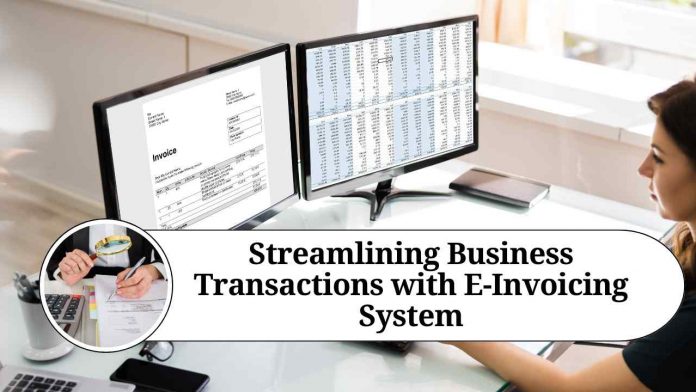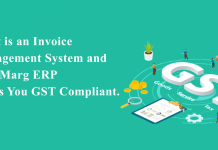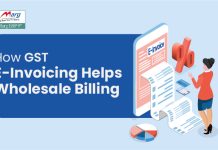Introduction
In today’s digital age, businesses are constantly seeking ways to improve efficiency and reduce costs. One significant area of focus is the invoicing process, which traditionally involves manual tasks, paper-based documents, and time-consuming procedures. However, with the advent of technology, the landscape of invoicing has transformed significantly. Enter the e-invoicing system – a powerful tool that streamlines business transactions, enhances accuracy, and optimizes financial operations. In this blog post, we will explore the benefits and functionalities of e-invoicing, highlighting how it revolutionizes the way businesses handle invoicing tasks.
- Understanding E-Invoicing: E-invoicing, or electronic invoicing, is the process of generating, sending, and receiving invoices electronically, eliminating the need for paper-based invoices. It leverages digital platforms and standardized data formats to facilitate seamless transactions between buyers and suppliers. E-invoices contain all the essential details of a traditional invoice, such as invoice number, item descriptions, quantities, prices, and payment terms. However, they offer added advantages in terms of automation, accuracy, and speed.
- Advantages of E-Invoicing: 2.1 Enhanced Efficiency: E-invoicing eliminates manual data entry and reduces the potential for errors, leading to increased operational efficiency. With automated processes, businesses can save significant time and resources that would otherwise be spent on manual tasks, such as printing, mailing, and storing paper invoices.
2.2 Cost Savings: The transition from paper-based to electronic invoicing results in substantial cost savings for businesses. E-invoicing reduces expenses associated with printing, postage, and physical storage. Moreover, it minimizes the risk of late payments and associated penalties, ensuring timely settlements and optimizing cash flow.
2.3 Improved Accuracy and Compliance: E-invoicing systems leverage data validation and verification techniques to ensure the accuracy and completeness of invoice information. Automated processes reduce the likelihood of errors, such as incorrect calculations or missing data. Additionally, e-invoicing promotes compliance with tax regulations and invoicing standards, reducing the chances of audits or penalties.
2.4 Faster Processing and Payments: E-invoicing streamlines the invoice approval and payment processes. Digital invoices are delivered instantaneously, allowing for prompt review and faster payment cycles. This efficiency benefits both suppliers and buyers, leading to improved relationships and cash flow management.
2.5 Enhanced Visibility and Analytics: E-invoicing systems provide real-time visibility into the invoicing process, allowing businesses to track invoice statuses, monitor payment trends, and gain insights into their financial operations. These analytics enable informed decision-making and help identify areas for improvement, such as optimizing cash flow or negotiating better payment terms.
- Key Features of E-Invoicing Systems: 3.1 Integration: E-invoicing systems seamlessly integrate with accounting and enterprise resource planning (ERP) software, enabling data synchronization and reducing manual interventions. Integration ensures a smooth flow of information, enhances accuracy, and eliminates redundant data entry.
3.2 Secure Data Transmission: E-invoicing platforms employ encryption and secure data transmission protocols to protect sensitive financial information. This ensures that invoices are delivered safely, protecting businesses and their customers from potential security breaches or data leaks.
3.3 Standardization: E-invoicing adheres to standardized data formats, such as Universal Business Language (UBL) or electronic data interchange (EDI) formats, promoting interoperability between different systems. Standardization facilitates seamless communication and data exchange, enabling businesses to connect with various trading partners and comply with regulatory requirements.
3.4 Automated Workflows: E-invoicing systems automate the entire invoicing process, from invoice generation to payment reconciliation. Automated workflows reduce manual errors, enable quicker approvals, and provide real-time visibility into invoice statuses,
conclusion
E-invoicing revolutionizes the way businesses handle invoicing tasks, bringing numerous benefits such as increased efficiency, cost savings, improved accuracy, faster processing, and enhanced visibility. Implementing an e-invoicing system can streamline financial operations, optimize cash flow, and improve overall business performance.
Read more useful content:
Frequently Asked Questions (FAQs)
Q. What is e-invoicing?
E-invoicing, or electronic invoicing, is the process of generating, sending, and receiving invoices electronically. It eliminates the need for paper-based invoices and leverages digital platforms and standardized data formats to facilitate seamless transactions between buyers and suppliers.
Q. How does e-invoicing work?
E-invoicing works by utilizing digital platforms and automated processes to generate, send, receive, and process invoices. It involves the use of structured data formats, such as XML or EDI, to ensure standardized and machine-readable invoices. E-invoicing systems integrate with accounting or ERP software to synchronize data and streamline the invoicing process.
Q. What are the benefits of e-invoicing?
Some key benefits of e-invoicing include enhanced efficiency, cost savings, improved accuracy and compliance, faster processing and payments, and enhanced visibility and analytics. E-invoicing reduces manual tasks, minimizes errors, speeds up payment cycles, and provides real-time insights into financial operations.
Q. Is e-invoicing legally recognized?
Yes, e-invoicing is legally recognized in many countries around the world. Governments have introduced regulations and frameworks to support the adoption of e-invoicing and ensure its authenticity and integrity. It is essential to comply with local tax regulations and invoicing standards when implementing e-invoicing systems.
Q. Is e-invoicing secure?
E-invoicing systems prioritize data security by employing encryption and secure data transmission protocols. This ensures that sensitive financial information is protected during invoice delivery and prevents security breaches or data leaks. It is crucial to choose reputable e-invoicing service providers and follow best practices to maintain data security.
Q. How does e-invoicing improve accuracy and compliance?
E-invoicing systems automate the validation and verification of invoice data, reducing the likelihood of errors, such as incorrect calculations or missing information. By adhering to standardized data formats and complying with invoicing regulations, businesses can ensure accurate and compliant invoices, minimizing the risk of audits or penalties.
Q. Can e-invoicing integrate with existing accounting or ERP systems?
Yes, e-invoicing systems are designed to integrate seamlessly with existing accounting or ERP systems. Integration allows for the synchronization of data, eliminates redundant data entry, and ensures a smooth flow of information between different systems. This integration enhances accuracy and efficiency in financial operations.
Q. Can e-invoicing be used for international transactions?
Yes, e-invoicing can be used for international transactions. Many e-invoicing systems support multiple languages and currencies, enabling businesses to communicate with their international trading partners. However, it is crucial to consider local invoicing regulations and compliance requirements when conducting cross-border transactions.
Q. How does e-invoicing impact cash flow management?
E-invoicing improves cash flow management by facilitating faster invoice processing and payments. Digital invoices are delivered instantly, allowing for prompt review and approvals, leading to quicker payment cycles. Businesses can monitor invoice statuses in real-time, enabling better cash flow forecasting and optimizing working capital.
Q. What are the cost savings associated with e-invoicing?
E-invoicing leads to significant cost savings by eliminating expenses related to paper, printing, postage, and physical storage of invoices. Additionally, the automation of processes reduces the need for manual labor, minimizing human errors and reducing administrative costs. Prompt payments and optimized cash flow also contribute to cost savings by avoiding late payment penalties.




















